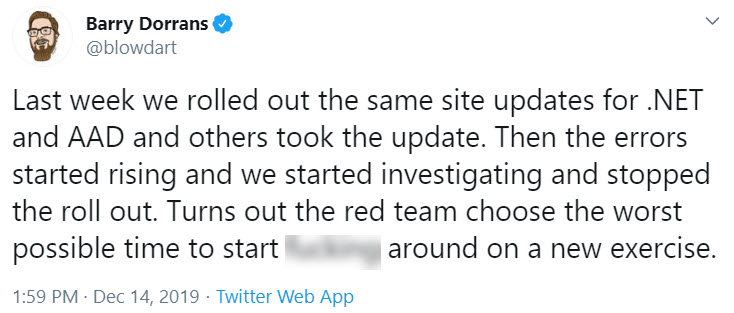Newsletter Archives
-
MS-DEFCON 4: A “sort of” quiet February

ISSUE 21.09.1 • 2024-02-27 
By Susan Bradley
The February updates have generally been well behaved, with one major exception: gamers.
Otherwise, things have been mostly quiet. That’s why I feel comfortable lowering the MS-DEFCON level to 4. Patches are unlikely to cause most users any problems.
Anyone can read the full MS-DEFCON Alert (21.09.1, 2024-02-27).
-
Microsoft kills off Internet Explorer — mostly

ISSUE 20.08 • 2023-02-20 PATCH WATCH

By Susan Bradley
Not feeling the love from Microsoft this month?
That might be because the company is saying goodbye to its aged Internet Explorer Web browser (IE), albeit only on certain platforms.
For Windows 10, the death of IE is not part of this month’s Windows update but rather part of the update to the Edge browser. That update would have been in the background, silent, and you may not have noticed it. Even if you did, you probably didn’t pay much attention. Unless, of course, you had moved from IE to Edge a while back. For you, the update re-migrated your favorites and bookmarks, making a duplicate list.
Read the full story in our Plus Newsletter (20.08.0, 2023-02-20).
This story also appears in our public Newsletter. -
Microsoft re-releases buggy July .NET Security Only patches
Microsoft just announced that it has re-issued the buggy July .NET Security Only patches identified as CVE–2020-1147, and covering a gazillion different KBs. Okay, I overspoke. Maybe half a gazillion.
The bug? Ahem:
After you apply this update, some applications experience a TypeInitializationException exception when they try to deserialize System.Data.DataSet or System.Data.DataTable instances from the XML within a SQL CLR stored procedure.
You had to ask.
Anyway, if you see a .NET patch from July suddenly appear in October, you need to install it, and now you know why.
UPDATE: @PKCano has the gory details – including KB numbers for the re-released Security Only patches for Win7 and Server 2008 R2 – posted here.
-
Problems with the .NET updates
This from Barry Dorrans on Saturday:

It isn’t clear to me which .NET updates he’s talking about, but Barry knows whereof he speaks. He goes on to say that admins can block the rollout using opt out switches “in the comments in the blog post.” And he’s on vacation.
I’m going to guess that he’s referring to KB 4533002 but may well be wrong. That patch is still available in the Update Catalog.
Anybody have more details?
-
Report: The new .NET updates break Veritas Backup Exec
Two days ago, Microsoft released a bunch of patches for .NET Framework 3.5, 4.7.2 and 4.8.
Now comes word from Günter Born that they’re breaking Veritas Backup Exec.
The updates (per deskmodder.de):
- KB4511517 Win10 1809 .NET Framework 3.5 and 4.7.2
- KB4511522 Win10 1809 .NET Framework 3.5, 4.8
- KB4511521 Win10 1803 .NET Framework 4.8
- KB4511520 Win10 1709 .NET Framework 4.8
- KB4511519 Win10 1703 .NET Framework 4.8
- KB4511518 Win10 1607 .NET Framework 4.8
They all claim to fix the bug “Addresses a crash that occurs after enumerating event logs in Bass Class Library (BCL).”
Born has a translation of a German blog post that says after installing the .NET 4.8 patches, Veritas BackupExec 20.4 won’t start. Apparently, rolling back the patch brings Backup Exec back to life.
Have you had any problems with the .NET patches?
-
The July .NET patches are even worse than you think
Earlier today, Microsoft posted this advisory on the official MSDN .NET blog:
The July 2018 Security and Quality Rollup updates for .NET Framework was released earlier this month. We have received multiple customer reports of applications that fail to start or don’t run correctly after installing the July 2018 update.. A COM component fails to load because of “access denied,” “class not registered,” or “internal failure occurred for unknown reasons” errors.
We have stopped distributing the .NET Framework July 2018 updates on Windows Update and are actively working on fixing and re-shipping this month’s updates…
Workaround
Temporarily uninstall the July 2018 Security and Quality Rollup updates for .NET Framework to restore functionality until a new update has been released to correct this problem.
It’s been a banner month for Microsoft patches
-
What’s happening with Win7 .NET updates?
Just got this from reader OC:
Today I received from MS new updates for my Win 7 Pro, x64, SP1 (to be installed when I decide to), for .NET 4.6.4, 4.61. 4.62, 4.7; another for 4.5.2 and a third for 3.5.1.
They are, respectively, kb4040973; … 77; … 80 (the first 5 digits are the same for all three.)Further, the message says they replace kb2978120 and … 28.
Now, when going to the MS page with the explanation and I click on the corresponding kb, say …73 to go to the site where there is a link to the MS site where I can download it, that takes me to a page for …86; when I click on the next one, it also takes me to a page for a different kb, and same for the third one. And they are all include fixes, not the ones advertised in the message, but for … 4.7 ! (Which, according to your site, is best avoided, for now.)
I hope this can be cleared out in the not too distant future. In the meantime, I am keeping this update parked “unticked” in my machine, until that clarification happens, or until postings in your site advise that it is OK to go ahead and install them as they are, or…
-
Why is it so hard to push good .NET patches?
Hard to imagine what patching Windows 8 will be like, if MS can’t even get .NET 3.0 patched correctly.
InfoWorld Tech Watch.


